Imagine walking through the picturesque landscapes of Texas or South Carolina, basking in the beauty of nature, when suddenly, you come across a venomous snake! It’s a scenario many people fear, but with knowledge and understanding, you can easily navigate the world of these fascinating creatures.
Texas is home to a greater number of venomous snake species compared to South Carolina, with 15 species residing in the Lone Star State and only 6 in the Palmetto State. The unique environments in Texas, ranging from arid deserts to dense forests, contribute to this higher species diversity.
In this article, we’ll dive into the world of venomous snakes in Texas and South Carolina. We’ll compare the species found in each state, discuss their distribution, and uncover the fascinating world of snake activity. Along the way, we’ll provide tips on what to do if bitten by a snake.
Join us as we explore the slithery wonders of these two states and unravel the mysteries of their venomous residents!
Texas Venomous Snakes
Texas is home to over 15 species of venomous snakes, each with its unique characteristics and behaviors. The table below highlights the main types of venomous snakes in the Lone Star State:
| Type of Snake | Habitat |
|---|---|
| Western diamondback rattlesnake | Often inhabit grasslands, deserts, and rocky areas |
| Timber rattlesnake | Prefer wooded and hilly environments in eastern Texas |
| Mojave rattlesnake | Inhabit arid regions of West Texas |
| Prairie rattlesnake | Commonly found in grasslands, prairies, and desert areas |
| Black-tailed rattlesnake | Favor rocky and mountainous habitats |
| Rock rattlesnake | Typically found in rocky environments |
| Mottled rock rattlesnake | Typically found in rocky environments |
| Cottonmouth (water moccasin) | Primarily found near water sources like rivers, lakes, and swamps |
| Copperhead | Favor wooded and rocky environments, but they can also be found in suburban areas. |
| Coral snake | Prefer moist, wooded habitats and are often found under logs or leaf litter. |
When Are Snakes Most Active in Texas?
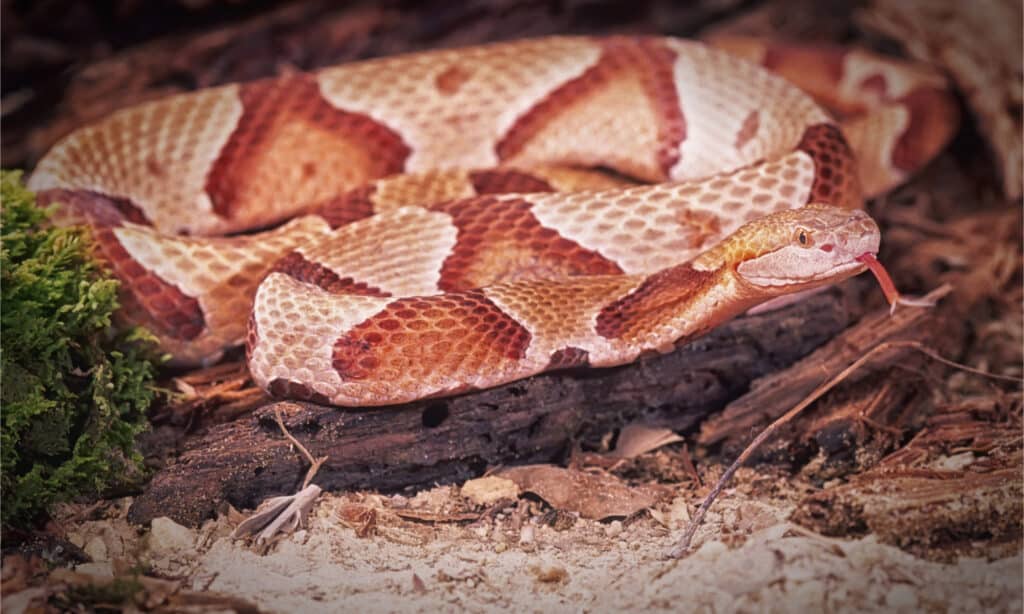
Snakes, including copperheads, become more active in warm temperatures.
©outdoorsman/Shutterstock.com
Snakes exhibit different activity patterns depending on the season and time of day. Let’s delve into the specifics of these activity patterns for the various venomous snakes in Texas.
Seasonal Activity Patterns
As temperatures begin to rise in spring, snakes become more active in their search for food and mates. This period is considered the peak breeding season for many snake species, including rattlesnakes and copperheads.
During the summer months, snakes may alter their activity patterns to avoid extreme temperatures. They may become more nocturnal, searching for food and shelter during the cooler nighttime hours. Cottonmouths may be more active during this time due to their semi-aquatic nature and their preference for cooler, wet environments.
As temperatures cool down in the fall, snakes remain active during the day, taking advantage of the more temperate conditions. This is also the time when many young snakes are born, increasing the overall snake population.
In Texas, some snake species may remain active during mild winters, especially in the southern regions of the state. But many snakes will become less active or brumate, a period of dormancy similar to hibernation during colder months.
Daily Activity Patterns
Some venomous snakes in Texas, such as the prairie rattlesnake and the copperhead, are primarily diurnal, meaning they are most active during the day. However, their activity patterns often shift depending on the season and temperature.
Other snake species, like the western diamondback rattlesnake, may exhibit nocturnal behavior, especially during the hot summer months when daytime temperatures are high.
Some snakes, such as the Texas coral snake, are considered crepuscular, meaning they are most active during dawn and dusk when temperatures are more moderate. This activity pattern may help them avoid predators that are active during the day or night.
The Most Common Venomous Snakes in Texas
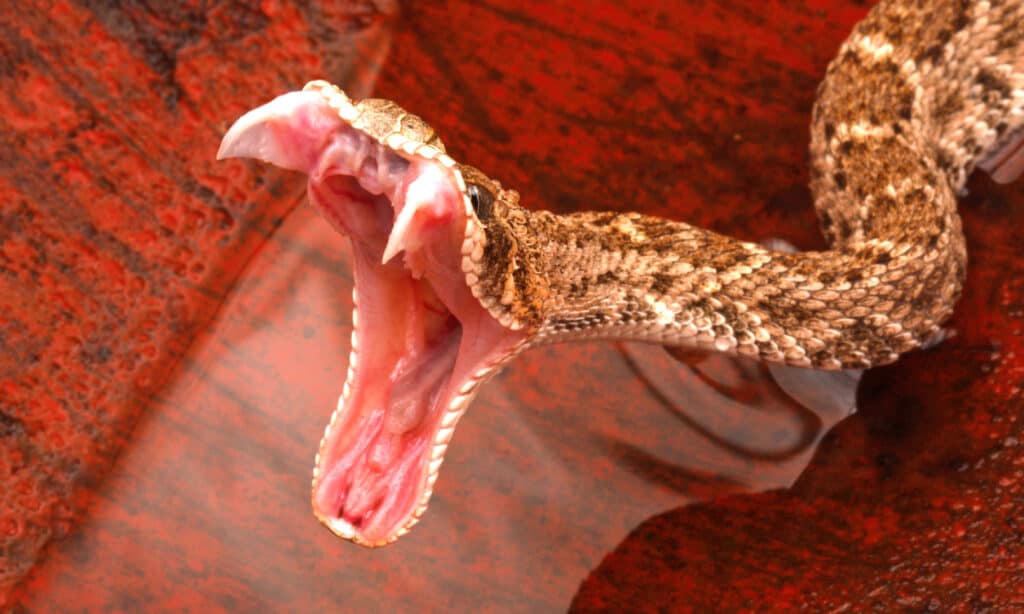
Frightening as they may be, western diamondback rattlesnakes are quite common in Texas.
©iStock.com/johnaudrey
In Texas, several venomous snakes are more likely to be encountered due to their widespread distribution and preference for habitats that are close to human activity. Let’s find out the most common venomous snakes in Texas, highlighting their characteristics and habitats.
- Rattlesnakes. Western diamondback and prairie rattlesnakes are the most commonly encountered rattlesnakes in the western half of Texas. In the east, you’ll run across timber rattlesnakes more often. They can be found in various habitats, such as grasslands, prairies, deserts, and rocky terrains. Western diamondback rattlesnakes are the most common type responsible for snakebites in Texas due to their nervous, defensive nature and prevalence in the state.
- Cottonmouths. Also known as water moccasins, cottonmouths are semi-aquatic pit vipers frequently found near bodies of water, such as rivers, lakes, and swamps. Though their venom is less potent than rattlesnakes’, their bites can still be painful and dangerous.
- Copperheads. These are medium-sized pit vipers with distinctive copper-colored heads and hourglass-shaped banding patterns on their bodies. They prefer wooded and rocky environments but can also be found in suburban areas, increasing the chances of human encounters.
Rarely Encountered Venomous Snakes in Texas
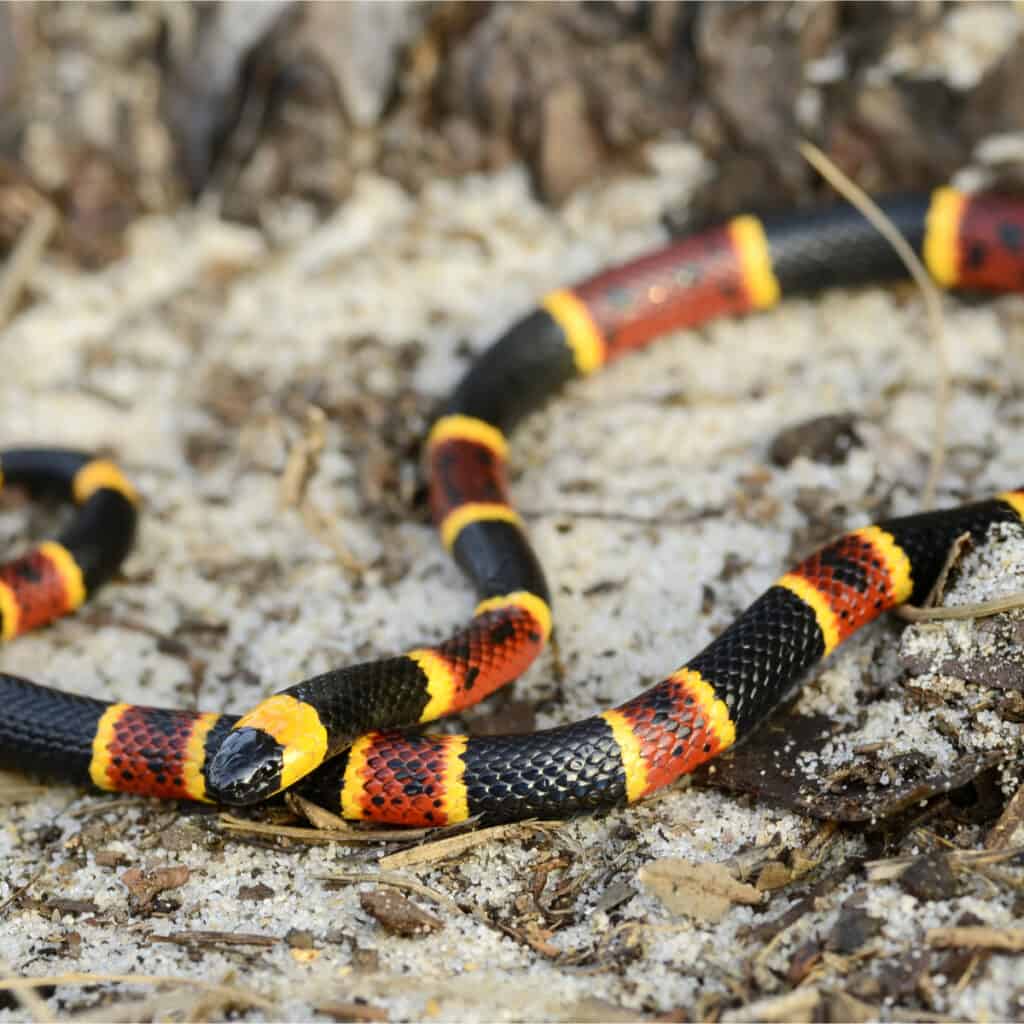
Encounters with coral snakes are rare because coral snakes prefer to remain hidden.
©Patrick K. Campbell/Shutterstock.com
Some venomous snakes in Texas are seldom seen due to their shy nature, secretive habits, or specific habitat preferences. Let’s focus on the elusive coral snake, which is one such species.
Texas coral snakes are members of the Elapidae family and have a unique red, yellow, and black banding pattern. They prefer moist, wooded habitats and are often found under logs or leaf litter. Despite their potent neurotoxic venom, encounters with coral snakes are rare because they generally avoid confrontations and stay hidden.
Which of Texas’ Venomous Snakes Have the Highest Venom Toxicity?
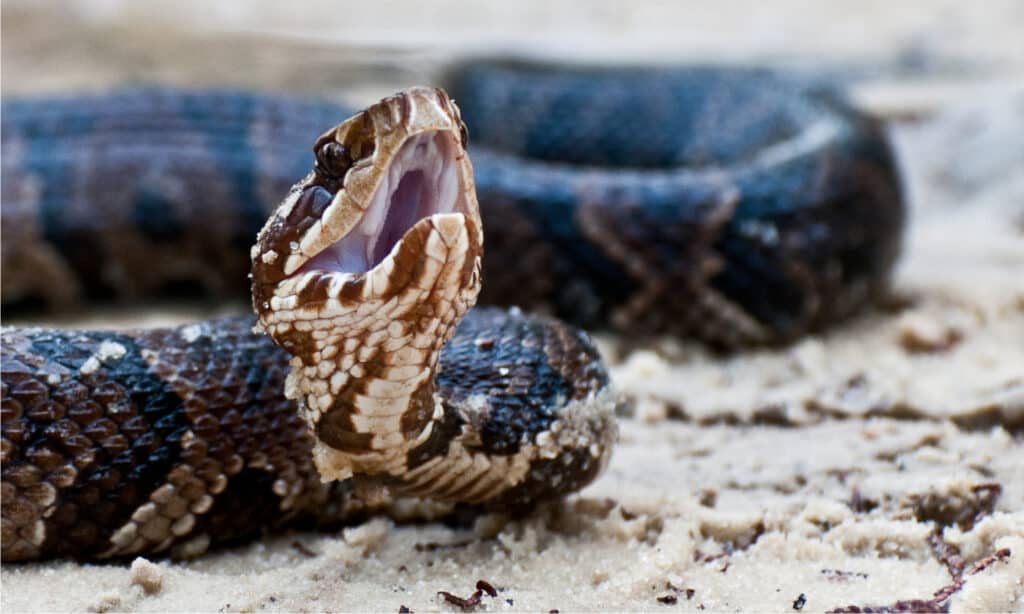
Cottonmouths have less potent venom than coral snakes or rattlesnakes, but they are still dangerous.
©Jay Ondreicka/Shutterstock.com
Venom toxicity varies among the venomous snakes found in Texas. Understanding the potency of each species’ venom can help people better assess the potential danger they may face when encountering these snakes.
- Texas coral snakes. Coral snakes possess the most toxic venom among Texas snake species. But their bites are rare due to their elusive nature.
- Rattlesnakes. Rattlesnakes, particularly the western diamondback, have potent venom and are responsible for the majority of venomous snakebites in Texas.
- Cottonmouths and copperheads. They have less potent venom compared to rattlesnakes and coral snakes. But their bites can still cause significant pain, swelling, and tissue damage.
How Common Are Snakebites in Texas?
While venomous snakebites are relatively rare, it’s essential to be aware of the risks and take precautions when spending time outdoors in Texas. The risk of encountering a venomous snake and being bitten can vary depending on the specific region and habitat you’re in.
- Western diamondback rattlesnake and copperhead bites are the most common type of venomous snakebite in Texas.
- Prairie rattlesnake, rock rattlesnake, and mottled rock rattlesnake bites also occur, though less frequently than western diamondback bites.
- Cottonmouth bites are less common but can still pose a risk.
- Coral snake bites, as well as bites from the rarer rattlesnake species like timber rattlesnake, Mojave rattlesnake, and black-tailed rattlesnake, are uncommon due to their elusive nature and preference for staying hidden.
South Carolina Venomous Snakes
South Carolina, known for its picturesque landscapes and diverse wildlife, is also home to over six venomous snake species. Understanding the various types of venomous snakes in the Palmetto State can help residents and visitors safely coexist with these fascinating creatures. The table below highlights some of the venomous snakes found in South Carolina.
| Type of Snake | Habitat |
|---|---|
| Copperhead | Are widespread throughout the state and can be found in wooded, rocky, and suburban areas |
| Cottonmouth (water moccasin) | Prefer areas near water sources like rivers, lakes, and swamps, and are more common in the coastal regions of South Carolina. |
| Eastern diamondback rattlesnake | Favor longleaf pine forests and sandhills but are increasingly rare in the state due to habitat loss |
| Timber rattlesnake | Inhabit deciduous forests and mixed woodlands, particularly in the mountainous regions of South Carolina. |
| Pygmy rattlesnake | Are found in pine flatwoods, sandhills, and other upland habitats but are generally rare in the state |
| Eastern coral snake | Prefer moist, wooded environments and are found mainly in the southeastern part of South Carolina. |
When Are Snakes Most Active in South Carolina?
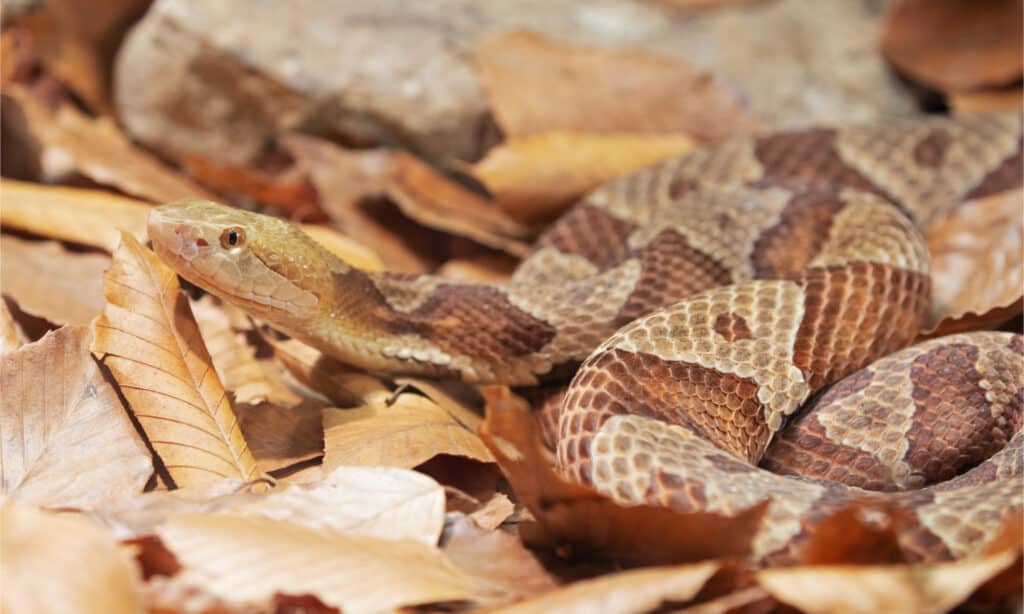
Be wary of copperheads during dawn and dusk, as this is when they’re most active.
©DnDavis/Shutterstock.com
Snakes exhibit different activity patterns depending on the season and time of day.
Seasonal Activity Patterns
Many snake species, including rattlesnakes and copperheads, become more active in the spring as temperatures rise, and they search for food and mates.
During the hot summer months, snakes may shift their activity patterns to avoid extreme temperatures, becoming more nocturnal.
As temperatures cool in the fall, snakes remain active during the day and take advantage of the more temperate conditions.
Most snakes in South Carolina become less active or brumate during the colder months.
Daily activity patterns
Some venomous snakes, such as the timber rattlesnake, are primarily diurnal, meaning they are most active during the day.
Other snake species, like the eastern diamondback rattlesnake, may exhibit nocturnal behavior, especially during the hot summer months.
Some snakes, such as the copperhead, are most active during dawn and dusk when temperatures are more moderate.
The Most Common Venomous Snakes in South Carolina
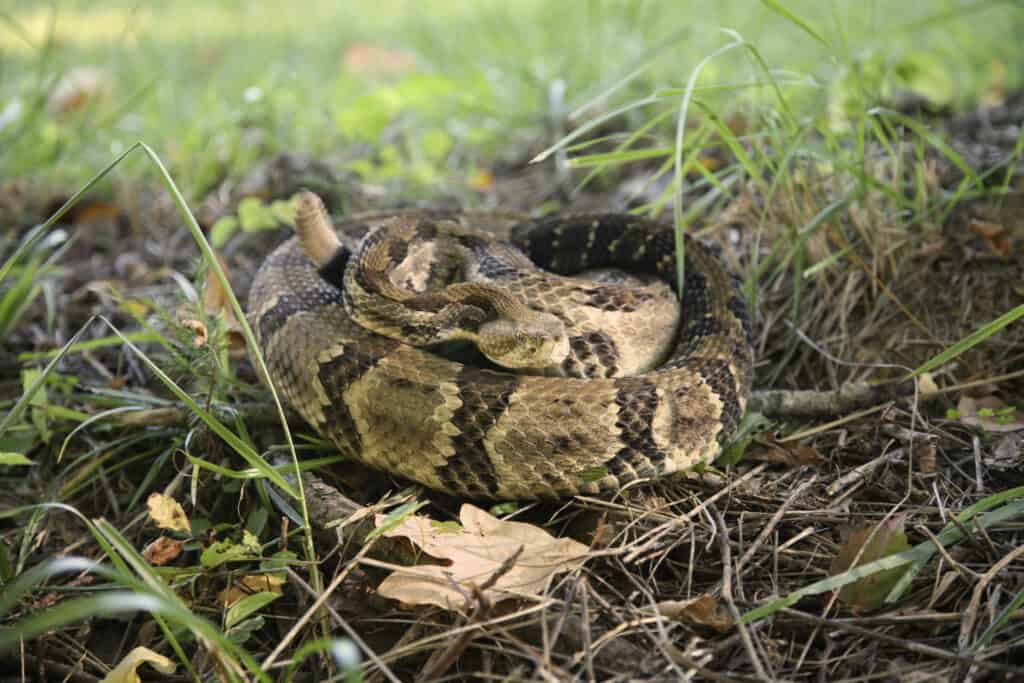
Timber rattlesnakes are extremely venomous, but they are not typically aggressive.
©iStock.com/NajaShots
In South Carolina, several venomous snakes are common encounters due to their widespread distribution and habitat preferences. Let’s delve into the three most common venomous snakes found in the state.
- Copperheads. These medium-sized pit vipers have distinctive copper-colored heads and hourglass-shaped banding patterns on their bodies. They commonly frequent wooded and rocky areas, as well as suburban neighborhoods, increasing the likelihood of human encounters.
- Cottonmouths. These semi-aquatic pit vipers inhabit areas close to bodies of water like rivers, lakes, and swamps. You can identify cottonmouths by their dark, thick bodies and the distinctive white lining inside their mouths when they open them in a defensive posture.
- Timber rattlesnakes. These large pit vipers live in deciduous forests and mixed woodlands, particularly in the mountainous regions of South Carolina. The distinctive rattle at the end of their tails and a wide variation in color patterns, ranging from yellow and brown to gray and black, distinguish them. Though they aren’t typically aggressive, their bites can be severe due to the potency of their venom.
Rarely Encountered Venomous Snakes in South Carolina
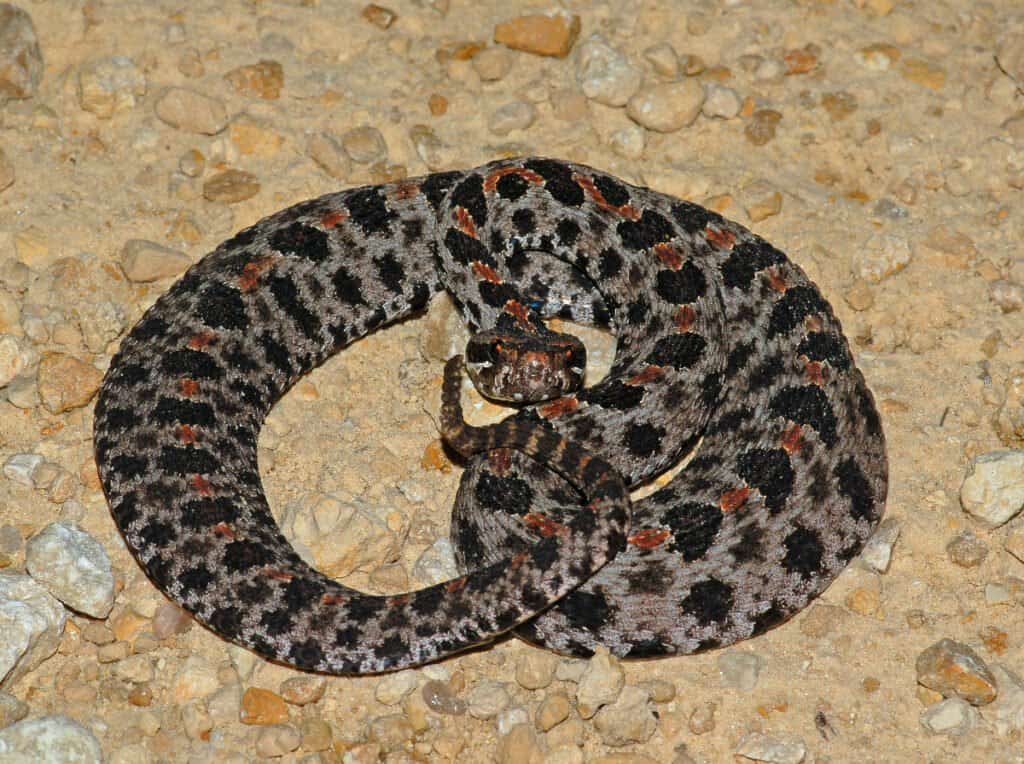
While generally rare in South Carolina, pygmy rattlesnakes live throughout the state, with the exception of its mountainous regions.
©Gerald A. DeBoer/Shutterstock.com
While some venomous snakes in South Carolina are more commonly encountered, others remain elusive due to their rarity, specific habitat requirements, or elusive behaviors. Let’s explore three of the less frequently encountered venomous snakes in the state.
- Eastern diamondback rattlesnake. Once more common in South Carolina, the eastern diamondback rattlesnake has become increasingly rare due to habitat loss. These large, heavy-bodied snakes have a distinctive diamond pattern on their backs and a potent venom that can be life-threatening if not treated promptly.
- Pygmy rattlesnake. The smallest of South Carolina’s rattlesnakes, the pygmy rattlesnake, is generally rare in the state. However, they can be found in pine flatwoods, sandhills, and other upland habitats.
- Eastern coral snake. With their striking red, yellow, and black bands, eastern coral snakes are both beautiful and venomous. They are found mainly in southeastern South Carolina and prefer moist, wooded environments.
Which of Texas’ Venomous Snakes Have the Highest Venom Toxicity?
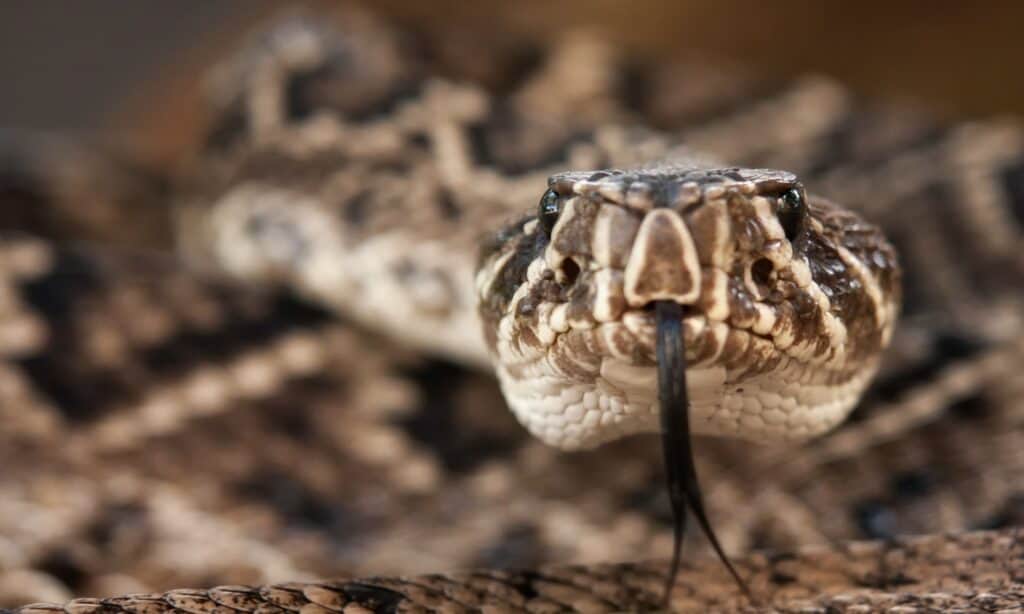
Eastern diamondback rattlesnakes have the most potent venom of all snakes in South Carolina.
©iStock.com/Wide-River-Rick
The venom potency of South Carolina’s snake species varies significantly, affecting the severity of their bites and the potential risks to humans. Let’s examine the venom toxicity levels among the state’s venomous snakes, ranking them based on the potency of their venom.
- Eastern diamondback rattlesnake. This species has the most potent venom among South Carolina’s venomous snakes, making their bites potentially life-threatening if not treated promptly.
- Timber rattlesnake. The venom of timber rattlesnakes is also highly potent, and their bites can result in severe symptoms and complications if left untreated.
- Eastern coral snake. Although bites from these snakes are rare, their neurotoxic venom is extremely potent and can lead to serious consequences, including respiratory failure and death.
What to Do If Bitten By a Snake

There are certain steps to take if a snake bites you, and knowing them is essential if you like exploring where snakes thrive.
©Microgen/Shutterstock.com
Although snakebites are relatively rare, it’s essential to know what to do in case of an emergency. So, let’s discuss the immediate steps to take if bitten by a venomous snake, along with essential precautions to ensure the best possible outcome.
Immediate Actions
If bitten by a venomous snake, it’s crucial to remain calm and take the following steps:
- Step #1: Call 911 or seek emergency medical assistance immediately.
- Step #2: Keep the affected limb immobilized and at or slightly below heart level to reduce the spread of venom.
- Step #3: Remove any tight clothing, jewelry, or accessories near the bite area, as swelling may occur.
- Step #4: Avoid attempting to suck the venom out of the wound or applying ice, heat, or tourniquets, as these actions may worsen the situation.
- Step #5: Take note of the snake’s appearance, if possible, to help identify the species and ensure proper treatment. But don’t attempt to capture or kill the snake, as this may put you at further risk.
Precautions and Misconceptions: What Not to Do
There are several misconceptions and potentially harmful actions to avoid when dealing with a snakebite:
- Don’t attempt to cut the bite area, as this may cause additional harm and increase the risk of infection.
- Avoid consuming alcohol or caffeine, as these substances can increase heart rate and blood flow, potentially worsening the effects of the venom.
- Don’t engage in physical activity or run, as this may speed up the circulation of venom through the body.
- Refrain from using electric shocks, as there is no scientific evidence to support their efficacy, and they may cause additional harm.
Medical Treatment
Once at the hospital, medical professionals will evaluate the severity of the bite and determine the appropriate course of action. They often administer antivenom to neutralize the venom’s toxic effects. Additional supportive care, such as pain management, wound care, and monitoring of vital signs, may also be provided to ensure the best possible outcome.
Key Takeaways
Throughout this article, we have explored the fascinating world of venomous snakes in Texas and South Carolina, delving into the diversity, behavior, and ecology of these captivating creatures. In addition, we have compared the populations of venomous snakes in both states, highlighting their similarities and unique characteristics.
Understanding what to do in the event of a snakebite is crucial for anyone venturing into areas inhabited by venomous snakes. Being prepared, staying calm, and seeking immediate medical assistance can significantly impact the outcome of a snakebite incident. In addition, knowledge and respect for these remarkable creatures help prevent dangerous encounters and contribute to a greater appreciation of the diverse and fascinating wildlife found in both Texas and South Carolina.
The photo featured at the top of this post is © Kristian Bell/Shutterstock.com
Discover the "Monster" Snake 5X Bigger than an Anaconda
Every day A-Z Animals sends out some of the most incredible facts in the world from our free newsletter. Want to discover the 10 most beautiful snakes in the world, a "snake island" where you're never more than 3 feet from danger, or a "monster" snake 5X larger than an anaconda? Then sign up right now and you'll start receiving our daily newsletter absolutely free.
Thank you for reading! Have some feedback for us? Contact the AZ Animals editorial team.







